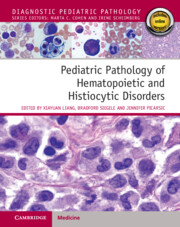Book contents
- Pediatric Pathology of Hematopoietic and Histiocytic Disorders
- Pediatric Pathology of Hematopoietic and Histiocytic Disorders
- Copyright page
- Epigraph
- Contents
- Contributors
- Section I General Hematology and Hematopathology
- Section II Non-Neoplastic Hematologic Disorders of Blood and Bone Marrow
- Chapter 3 Anemia
- Chapter 4 Bone Marrow Failure Syndromes
- Chapter 5 Inherited Leukocyte Disorders
- Chapter 6 Other Conditions
- Section III Non-Neoplastic Disorders of Extramedullary Lymphoid Tissues
- Section IV Neoplastic Disorders of Bone Marrow
- Section V Mature Lymphoid Neoplasms
- Section VI Histiocytic Disorders and Neoplasms
- Index
- References
Chapter 4 - Bone Marrow Failure Syndromes
from Section II - Non-Neoplastic Hematologic Disorders of Blood and Bone Marrow
Published online by Cambridge University Press: 25 January 2024
- Pediatric Pathology of Hematopoietic and Histiocytic Disorders
- Pediatric Pathology of Hematopoietic and Histiocytic Disorders
- Copyright page
- Epigraph
- Contents
- Contributors
- Section I General Hematology and Hematopathology
- Section II Non-Neoplastic Hematologic Disorders of Blood and Bone Marrow
- Chapter 3 Anemia
- Chapter 4 Bone Marrow Failure Syndromes
- Chapter 5 Inherited Leukocyte Disorders
- Chapter 6 Other Conditions
- Section III Non-Neoplastic Disorders of Extramedullary Lymphoid Tissues
- Section IV Neoplastic Disorders of Bone Marrow
- Section V Mature Lymphoid Neoplasms
- Section VI Histiocytic Disorders and Neoplasms
- Index
- References
Summary
Bone marrow failure syndromes comprise a heterogeneous group of disorders that may be inherited or acquired; may be static or progressive; and may affect any one hematopoietic lineage individually, multiple lineages, or all lineages collectively. The unifying feature consists of the failure of the bone marrow to supply the body with normal quantities of the mature forms of any of the three hematopoietic-lineage elements. Although bone marrow failure syndromes may engender a predisposition to the development of associated malignancies, and primary neoplastic processes involving the bone marrow and peripheral blood may meet the criteria of impaired hematopoiesis, discussion of neoplastic processes associated with cytopenias will be largely covered elsewhere.
- Type
- Chapter
- Information
- Publisher: Cambridge University PressPrint publication year: 2024

